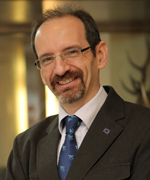Arturo Ariño, new director of the University of Navarra Science Museum
It is one of the most complete university museums in Spain, with more than two million specimens of 12,000 species.

Arturo Ariño, professor at department of Zoology and Ecology of the University of Navarra and expert in Biodiversity, is the new director of the Science Museum of the academic center. Formed by the Zoology Museum and the Natural Sciences Collection, the complex is one of the most complete in Spanish universities, with nearly two and a half million specimens of some 12,000 different species.
This university museum opened its doors in 1998 promoted by its former director, Professor Rafael Jordana, with the goal to exhibit a sample of several collections donated to the University, among which are the high school Nuestra Señora del Buen committee de Lecároz, which is the main part; the set of 2,500 shells and mollusks, bequest by José del Río; the sample of butterflies that Gómez Bustillo donated or the series of phytopathogenic insects by Adolfo Rupérez.
In addition to these, there are the collections of the department of Zoology and Ecology of the School of Sciences, from projects of research; and a sample of old containers, texts, tools and apparatus once used in pharmacy, Chemistry and photography, as well as a large mineralogical collection.
"Of the entire collection, only a small part is exhibited in 94 showcases spread over five floors at Sciences Building (Hexagon Building), at campus in Pamplona, where a total of 7,000 pieces from all over the world can be seen," explains Arturo Ariño. The vertebrate collection includes 890 pieces -most of them from high school de Lecároz- from 443 different taxa or species: "Among them, birds dominate, representing almost half of the specimens on display, and coming mainly from Eurasia, America, the Far East and Africa, coinciding with the geographical distribution of the missions and colleges of the order that ran this high school".
Unique pieces and other rarities
In the collection on display, adds his new director, stuffed and naturalized animals dominate, "although there are also quite a few skeletons, complete or partial, and other pieces such as skins or teeth. All of them accompanied by basic information that allows the public to locate them geographically, by species to which they belong, history, etc.". "Since," continues Arturo Ariño,"one of the central objectives of this Museum of the University of Navarra is to create an informative and didactic space open to the public, with conference open doors and guided tours for schools."
Finally, the specialist, who is also vice-president of the scientific committee of the Global Biodiversity Information Infrastructure (GBIF), emphasizes the research purpose of the Science Museum:"The collection is classified in a database accessible to all scientists in the world, and the collection on display can also be visited online. However, the series subject, of which we keep more than a hundred, and which correspond to specimens of reference letter in their species, are undoubtedly the ones that arouse the most queries".
